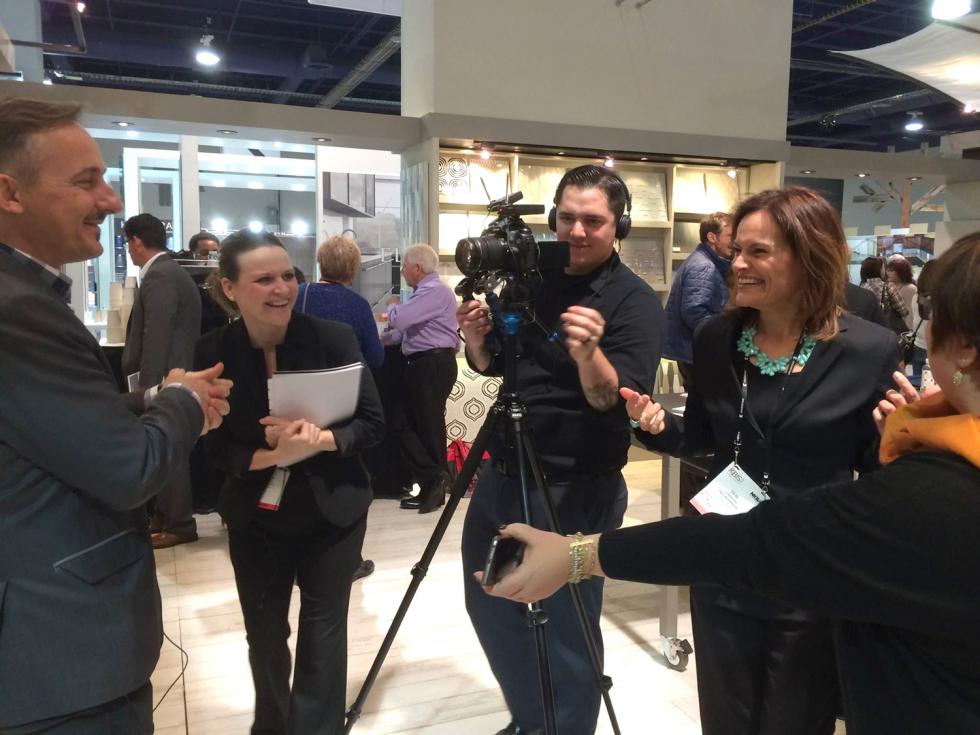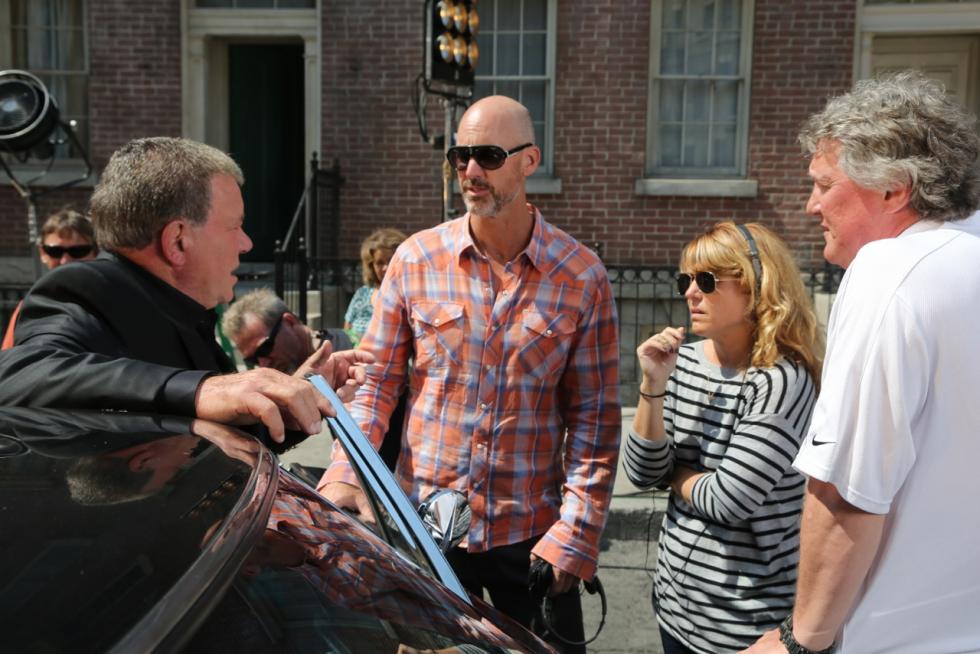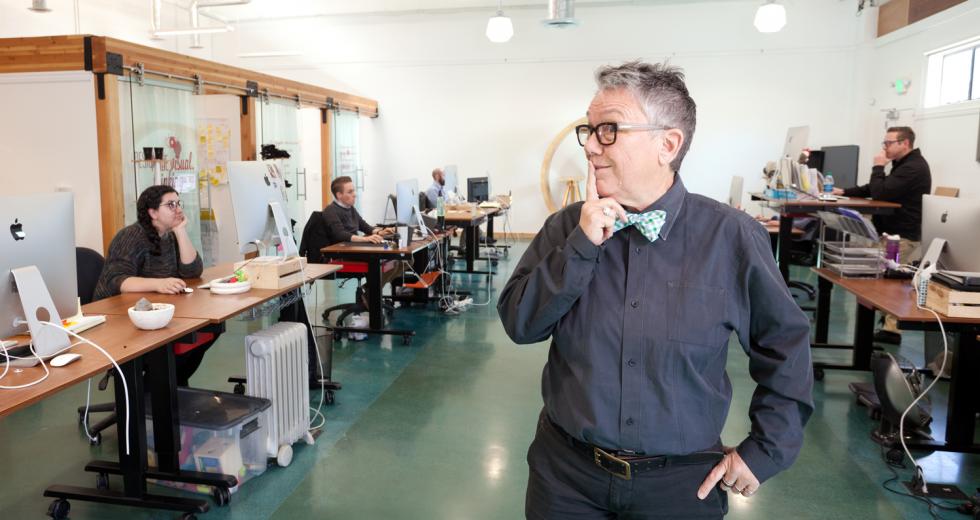In 1976, Tina Reynolds started her own design and marketing firm in Sacramento. Sales reps would knock on her door and ask to speak to the owner.
“I am the owner,” she’d tell them.
They’d usually laugh, and ask a second time.
That was then — when the sales reps, and most of her clients, colleagues and competitors, were men. She regularly received mail addressed to “Mr. Reynolds” and says in general, men seemed astonished to find a woman in charge.
Over the past 40 years, Reynolds has seen the industry evolve. “In the ‘80s, people started to recognize me as a business owner, but it was still male-dominated,” she says. In 1992 she started her current firm Uptown Studios, focusing more on nonprofits and small businesses. In the ’90s she began to see more women enter the industry. “And then in the 2000s, more young women arrived with an attitude of ‘I am doing this.’”
Related: Back and Forward: Debi Hammond on Marketing
Related: Be Your Own Champion
Today, women make up roughly half of the advertising industry, and many of Sacramento’s top ad agencies are now run by women. A 2017 article in Adweek detailed “how women dominate the creative community in Sacramento,” with 10 of its major agencies run by women. But it’s not just large advertising and marketing agencies; there are a myriad of small and boutique firms thriving in the city, as well. And the women running them say this means not only more authentic messaging, but a stronger support system for building up a new generation of women in advertising.
SACRAMENTO GROWN
Asking these executives “Why Sacramento?” leads to a lot of local boostering — these are advertisers, after all. But it goes beyond spin. Jane Einhorn, a former principal with Runyon Saltzman (formerly RSE) who recently broke out to start her own firm, attributes it to the “the California thing,” an attitude that is egalitarian, forward-looking and female-friendly.
Einhorn has been in the local industry since the late 1970s, and says it’s much easier now for women to both parent and participate in the workforce at the leadership level. “The problem with kids is that they get sick,” she says. “Back then, a woman had to come back to the house when that happened. They missed work.” Instead of putting her kids in day care, Einhorn hired a nanny to watch the kids at home. “That was very important for keeping me on the career track. Women who missed work faced a much more difficult time.” But times have changed.
Lori Bartle, president of MeringCarson (a large agency whose clients include Disney and the NFL), cites California’s generous policies for paternity leave as supporting women who want to work and parent by also supporting men to do the same. Bartle would often bring her daughter in to work when she was growing up. “Sacramento is a super family-friendly city,” she says. “And it attracts people for that reason. We get lots of women applying to us who want to have a family without sacrificing their career.”
The team at Merlot marketing led by founder and CEODebi Hammond
(far right, films a video news release for one of its clients.
Photo courtesy Merlot Marketing

Within California, Sacramento may have the best of what’s to offer. Meghan Phillips started the boutique firm Honey Agency in Sacramento 13 years ago, with the intent of ultimately relocating for the bright lights of L.A. or maybe New York after her firm grew. Instead, she says she found herself well-positioned to capitalize professionally on Sacramento’s “renaissance.” The city’s rebrand as America’s Farm-to-Fork Capital suited Phillips’ passion for food and wine, and she scored projects in agriculture (Far Horizon crop insurance), vineyards (Naggiar) and splashy events like the Tower Bridge Dinner.
Sacramento was no longer her stepping stone; it was the destination. “Starting Honey in a city where we had breathing room to create a niche without saturation was important,” Phillips says. She scotched any thoughts of moving, charmed by the city’s renewed emphasis on the startup scene, art and downtown culture. “I realized that I could create the agency that I wanted right here, as the story of Sacramento was still being told.”
Yet despite the organic feel and niche opportunities, the city still has a lot to offer larger agencies, says Debi Hammond, who launched Merlot Marketing in 2001. “I’m able to run a national firm out of Sacramento,” Hammond says. “I love the region and I love the hiking, and I love that I don’t have to fly in and out of LAX.”
THE MONEY’S IN THE MESSAGING
At the end of the day, the goal of every ad is to sell, and women are doing the buying. A 2009 study from Boston Consulting Group found that women are responsible (either directly or indirectly) for 71 percent of all consumer spending, including 91 percent of vacations, 91 percent of homes and even 60 percent of the traditionally “male-focused” category of automobiles.
“When we’re trying to come up with creative campaigning, I always want males and females in the room together. It creates a better product.” Debi Hammond, founder, Merlot Marketing
“From a business perspective, at least 50 percent of our target buyers are women,” says Kerry Krasts, creative director at MeringCarson. “Even when it’s for something that’s not for them, they are influential in the buying process.”
It is critical, therefore, to create ads or marketing campaigns that speak to this audience. Having more women at the table brings a diversity of voices that helps create authentic messaging. “Authenticity is the name of the game,” Bartle says. She points to Dove’s “Real Beauty” campaign, which features women of varying body types over the traditional airbrushed catwalk models. Compare that to Bic’s decision in 2012 to market a “lady pen” sold in a pink bag and an “elegant design — just for her” and a “thin barrel to fit a women’s hand.” (The backlash was instant, brutal and gloriously snarky. “Before these pens, I was nothing,” gushed one Amazon customer review. “I was a mere inconsequential woman, stumbling around writing nonsense with big pens that made me look ridiculous … But now … the whole world looks different.”)
This is not to say women are inherently “better” at advertising, but rather that a mix of voices yields more nuance and sparks creativity. “When we’re trying to come up with creative campaigning, I always want males and females in the room together. It creates a better product,” Hammond says.
Kerry Krasts, creative director at MeringCarson, with William
Shatner (far left) on the set for Visit California. Photo:
Courtesy of MeringCarson

A few years ago, Merlot was tasked with whipping up an ad for Dacor, the maker of luxury kitchen appliances. Hammond’s team racked their brains to come up with something more original than the standard glossy images of food typically used to sell food appliances. One of the female creatives said something to the effect of, Truffles! And then … Pigs! Truffles, as every proper foodie knows, are scavenged in the wild by pigs. So why not focus on the hog? Their final ad shows a close-up of a pig’s snout with the tagline, “If you know a Truffle Guy in France, you’re a Dacor Chef.” The ad, as Hammond sees it, found a more nuanced, emotional connection with the food and Dacor’s product. Others agreed; it nabbed an international Marcom Award and a Gold Addy Award from AAF Sacramento.
Authentic ads — and those that make an emotional connection — are more likely to be shared. “Women have the tendency to be a megaphone, to share something that they liked with their girlfriends,” Phillips says. So when designing, say, the label for a bottle of wine, Honey Agency’s ultimate goal is to tell a story. “We want her to read the label on the bottle and say, ‘Oh I absolutely love this Chianti — it’s from a married couple who gave up their corporate jobs to start a vineyard.’”
For Phillips, being a female-led firm has helped attract clients — she says she nabbed four projects in 2017 alone from clients explicitly looking to work with female-led ad agencies. A woman who owns a Washington-based hard cider company expressed to her that, “she believes that women have a deep connection with the palate, and a deep connection with the way packaging looks,” Phillips says. “She wanted to have a woman’s touch on the brand.”
Related: Women hold key artistic leadership positions at B Street Theatre
Ads do more than get us to use one product over another. Ultimately, they both shape and reflect our values. Uptown Studios’ Reynolds is ever-mindful of that influence, and she suggests that women are more likely to wield that power as a force for good. “Of course I’m generalizing, but for men … it’s about closing the deal,” Reynolds says. “The female perspective is a bit different.” She says that when she evaluates a potential client, she first asks: Is this going to be good for the community? “I’ve spoken to many firms that are setting up to sell cannabis, and I told them, ‘I’m not going to work with you unless you have strong messaging on teaching parents how to keep their kids safe,’” she says. Reynold’s also consults behind the scenes on the local and state level to discuss education and drug prevention methods for youth. “I’m really proud of that,” she says, “and it’s really not about the money.”
Reynolds also looks at the environmental impact. She has talked clients out of printing and mailing 8-page brochures, nudging them to a more eco-friendly solution. (Her firm used to print 150 copies of the 300-page annual budget for the City of Sacramento; now it’s all digital.) “I’ve been doing marketing and graphics for 42 years,” she says. “The thing that I know is that we decide what our clients do. They rely on us, the marketing firms, on what direction they should go in. We have all the power to say, ‘I don’t think you should use that packaging. It’s going to add to the landfill.’”
“Whenever a female student emails me questions, I suggest we get breakfast.” Tina Reynolds, president and founder, Uptown Studios
GROOMING THE NEXT GENERATION
If you swing by Pancake Circus on Broadway, there’s a decent chance you’ll spot Reynolds at a breakfast meeting, where she gives advice to up-and-comers. “Whenever a female student emails me questions, I suggest we get breakfast,” says Reynolds, who views mentorship as a crucial part of social responsibility and community-building. (She’s actively mentoring four women and two men.)
Ashley Rodseth, creative director at Honey Agency, idealtes a
project wit the team. Photo: Courtesy of Honey Agency

Every executive interviewed stressed the importance of mentorship. In 1979, when Einhorn joined Runyon Saltzman, she could point to Jean Runyon as a mentor and role model. Jean introduced her to key contacts, helped her keep a sense of humor, navigate stressful situations, and taught her that “If people like you, they won’t get mad if you make a mistake.” Perhaps most importantly, the strong mentor helped insulate her from the industry’s usual gender stigmas.
Over the years, Phillips’ mentors have given her advice that she has synthesized into three crisp personal takeaways, and she passes these down to women she advises. The first, and potentially most important: “Charge the right rate,” she says, adding that young up-and-comers need to clearly illustrate their value and then, when submitting a proposal, prepare for “being uncomfortable” with the asking price. The logic: If you’re too comfortable, then you’re not pushing hard enough. Reynolds agrees. “Go for the position that you don’t think you can get,” she says. “Shoot higher than you think you should, because it’s still going to be lower than you deserve.”
Second, Phillips advises to “Do what you do well, and delegate the rest.” She does not think of herself as a natural designer, art director or finance wizard, so she doesn’t micromanage. “I believe I lead well. But I’m not going to try and master HR or any of that,” she says, laughing. When she mentors young executives, she often asks for their to-do lists, and then she ruthlessly crosses off line after line, asking them, “Why on God’s green earth are you doing this?” she says.
Her final bit of advice? “In the ad industry, I do believe there are still a lot of claws,” Phillips says. “Don’t do that. Leave your ego at the door.”
These mentors are necessary because while progress has been made, challenges still remain. Einhorn says that for decades, she rarely saw women as creative directors. The numbers back this up: A 2017 study from the 3% Conference, an advocacy group for improving gender parity in advertising leadership, found that only 11 percent of creative directors are women. (The very name of the organization is a grim nod to the fact that the ratio used to be a paltry 3 percent). At least anecdotally, Sacramento appears to buck this trend: Honey Agency, Merlot and Uptown Studios all have female creative directors. “Now I see as many women creative directors as men,” says Reynolds, “but maybe that’s just me.”
Even with such a thriving and inclusive local industry scene, Hammond says old stereotypes can “somehow hang on like a tic.” She rattles them off: Women are too emotional; a woman who runs a business has a chip on her shoulder; women aren’t strong enough to speak up. “These are just stereotypes that need to fall by the wayside,” she says.
Krasts rarely sees that kind of “old boys’ club” vibe anymore. When she does, it is literally just with the “old.” “The men from the older generations are the ones who still have inappropriate comments, but the younger ones, I see none of that,” she says. She sees this ideology falling to the wayside in its twilight years. “Millennials keep making up a larger share of the business, eventually the problem will take care of itself,” she says.
Or as Reynolds says, “These days, everyone knows I’m the owner.”



